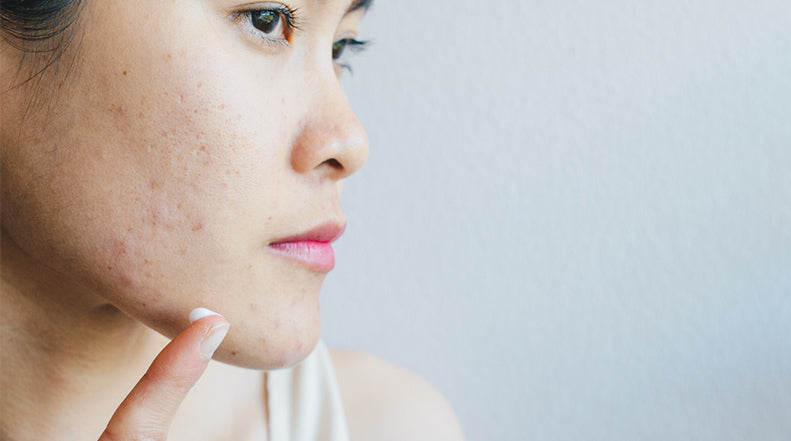4 Strategies for Reducing Atrophic Scars

Atrophic scars are characterized as a sunken area on a person’s skin, often looking pitted. In many cases atrophic scars are caused by collagen destruction as the result of experiencing inflammatory conditions such as acne or chickenpox. Atrophic scars can also be caused by accident, surgery or genetic disorders.
The presence of these marks can leave a person feeling uncomfortable about their physical appearance. As a result, many people with atrophic scars seek various methods to reduce the physical appearance of them. This article will review some of the steps that can be taken to reduce such scars.
TIP # 1 - PROPERLY IDENTIFY THE ATROPHIC SCARS
Atrophic scars exist when the healed top layer of a person’s skin is sunken below the rest of their dermis, creating pits. These scars form because the skin produces an inadequate amount of collagen, which is required to heal wounds. In many cases, a person will likely need to visit a medical professional to make a decision about whether the person has atrophic scars.
There are actually two types of atrophic scars: boxcar scars, ice pick, and rolling scars. Boxcar scars are characterized by steep borders with flat bottoms. Rolling scars, however, are characterized by broad and craterlike edges. Icepick acne is named because a person’s skin begins to look as if it had been punctured by an icepick and involves deep pits in a person’s skin that are 2 mm or less in length
After the extents of a person’s acne scarring has been determined, a physician can develop a treatment plan that will stimulate the skin to begin the healing process so that the surface of the healed region becomes even with the surrounding skin.
TIP # 2 - TREATMENT OPTIONS FOR ATROPHIC SCARS
There are several ways in which a dermatologist can help a patient with atrophic scars. Some of these methods include:
• Chemical treatments. Many dermatologist utilize a chemical peel to help regenerate cell growth in a person with atrophic acne. During this procedure, a chemical (most often glycolic acid or salicylic acid) is placed on the affected area and then removed. In removing the chemical, an outer layer of the person’s skin also is removed. In some situations, irritation can occur in patients who receive chemical treatments for atrophic acne.
• Dermabrasion. Dermabrasion involves freezing the patient’s skin during which time the patient is placed under anesthesia. The surgeon then used an instrument to remove the top layer of the person’s skin which causes the skin to heal and create a smoother appearance for the patient. There are two types of dermabrasion procedures that can be used to treat a person’s scar. The less invasive forms of these surgeries is microdermabrasion, which is a type of exfoliation during which the outer layer of a person’s skin in the affected area is removed. Another more invasive form of dermabrasion is used if a person’s skin has very deep pits due to scarring.
• Laser therapy. Pulse that emanates from a laser is used during these treatments to remodel the surface of a person’s skin.
• Microdermabrasion. This treatment is most often recommended to people who have mild atrophic acne scars. A hand-held device is used to blow crystals onto a person’s skin, which polish the surface of the skin. A vacuum tube is then used to remove these crystals along with skin cells from the person’s skin. The most outer layer of the patient’s skin is then removed, which often results in new skin growth.
• Soft tissue Filler. During this procedure, collagen is injected into the mid to deep dermis of person’s skin which raises the pits on the person’s skin.
TIP # 3 - USE THE CORRECT PRODUCTS
A person with atrophic scars should make sure to use gentle cleansing agents to remove bacteria, dirt, and oil from their face. Using harsher products can significantly irritate a person’s face.
When individuals with atrophic scars select moisturizers, it is also important to choose a product that does not contain irritants. It is a wise idea to purchase moisturizer that is specifically designed for sensitive skin and does not contain any dyes or fragrances. A person should then work the moisturizer into the affected area to avoid dry skin. Moisturizers are able to help maintain the necessary levels in a person’s skin to avoid irritation.
Individuals who are afflicted with atrophic scars should also avoid using soaps that have a tendency to cause dry skin. While taking a bath, it is also important to only gently pat a person’s skin and to avoid excessive scrubbing.
TIP # 4 - SILICONE TREATMENTS FOR ATROPHIC ACNE
While no topical treatments have been shown to improve atrophic scars, silicone gel can be used as the original pimple or chicken pox blister is healing. Silicone gel is recommended by scar experts to prevent abnormal scarring. NewGel+ offers two types of silicone gel that a person can apply to their skin to improve the final outcome of acne and chicken pox outbreaks. By treating atrophic scars early, a person can substantially reduce the severity of any scarring that occurs. If a person does eventually develop a crater like scars, consult a dermatologist to learn more about treatment options.




Comments